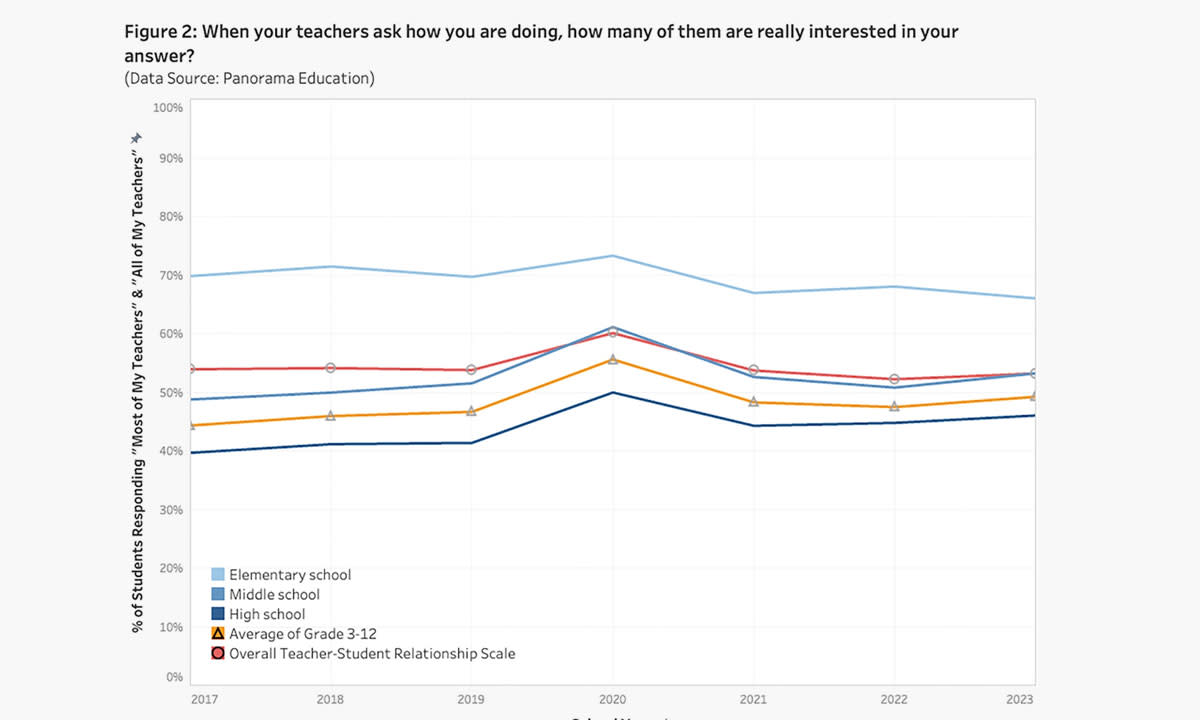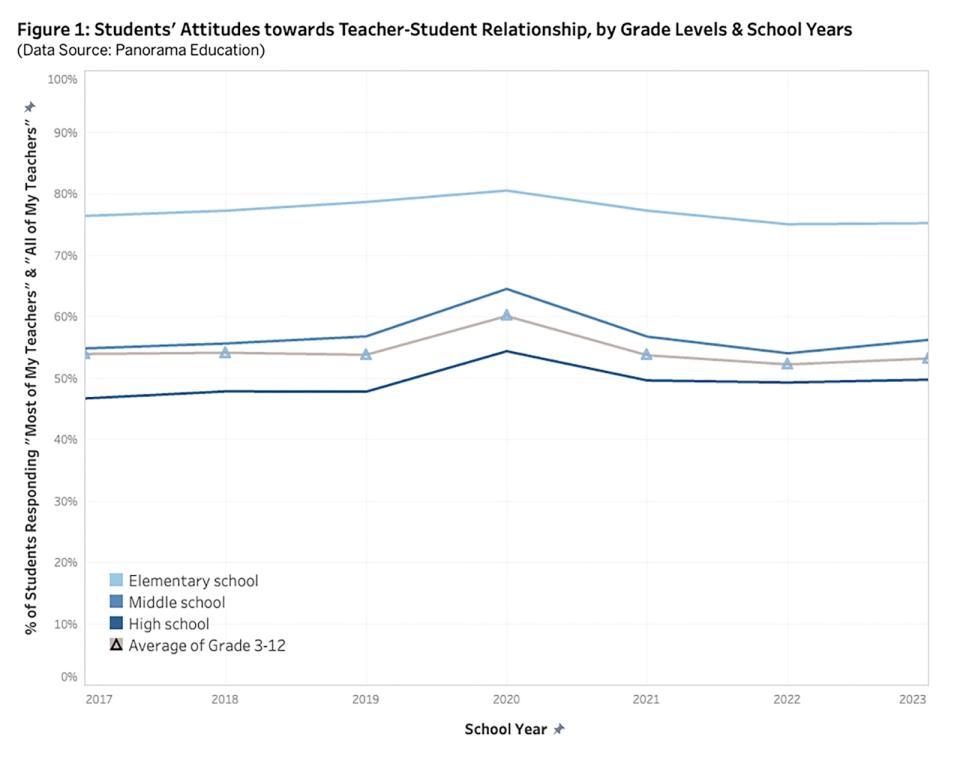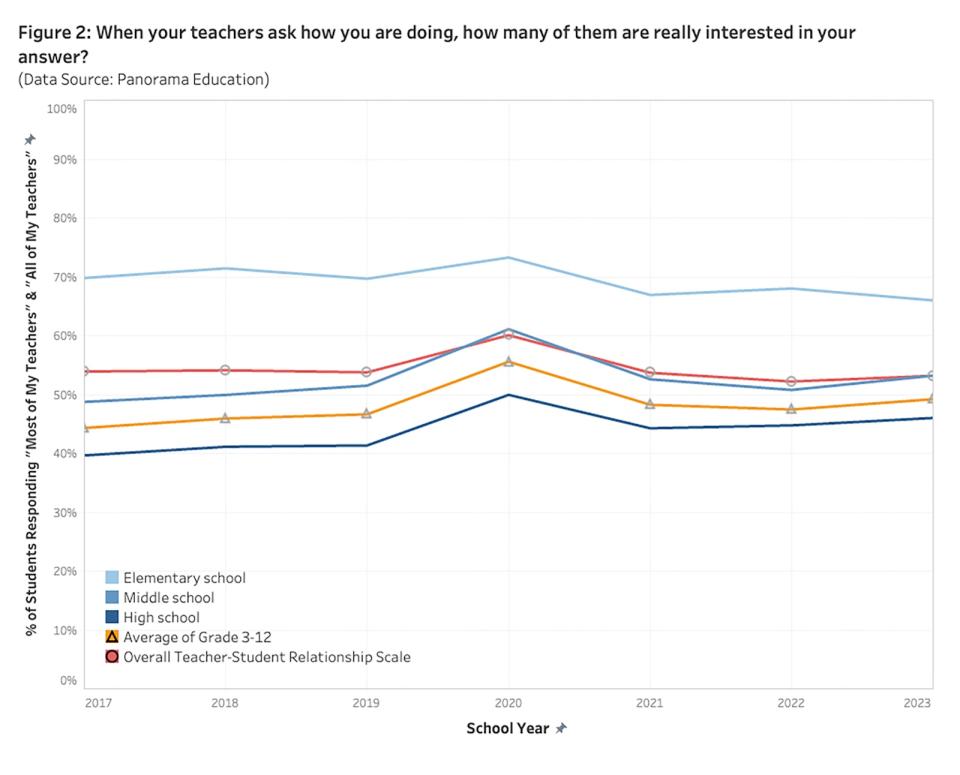Good Student-Teacher Relationships Spiked During COVID. How to Get Them Back

Given people’s forced isolation during COVID, the middle of the pandemic seems like the last place to find positive lessons about improving relationships. Yet, new data illuminates a social bright spot from the nation’s schools. The data, from Panorama Education — a company that helps school districts understand the perspectives and experiences of their students, families and teachers — found that students in grades 3 to 12 felt unusually positively toward their teachers in 2020, a year when nearly all indicators of student success were in freefall.
These findings, taken from a sample of almost 1.9 million students, parallel a Panorama analysis that tracked students over recent years. Given the tremendous stress and constrained interpersonal interactions that teachers faced in 2020, the pandemic bump shown below seems remarkable (particularly for middle and high school students). Just as noteworthy: When the pandemic receded, the improved relationships disappeared as quickly as they had emerged.
Get stories like these delivered straight to your inbox. Sign up for The 74 Newsletter

What might have caused these improved relationships? Why didn’t they last? And how might educators reproduce and sustain them in the future?
A second chart provides additional insights. Of the five questions Panorama used to measure teacher-student relationships, the one that yielded the largest pandemic jump from 2019 to 2022 was, “When your teachers ask you how you are doing, how many of them are really interested in the answer?” The increase in the percentage of students answering “frequently” or “almost always” was most pronounced for middle (from 52% to 61%) and high school students (from 41% to 50%). Yet, even elementary students, who already feel extremely positively, sensed that their teachers were unusually interested in how they were faring during COVID, with an increase from 70% to 73%. Presumably, as the pandemic faded, teachers felt less obligation to stay on top of all that their students were facing.
Yet, reverting to old patterns does not have to be inevitable. Educators who prioritize a rich understanding of their students’ experiences and who communicate that interest to their students will likely see these efforts pay off in multiple ways. Research shows that students who have positive relationships with their teachers learn more (as measured by grades and test scores), show up to school more frequently and behave better.

Given these benefits, the question naturally arises: How can these relationships be improved? One of the most promising levers for improving relationships, in the classroom, workplace or the home, is the capacity for social perspective-taking. For instance, researchers have found that teachers’ motivation and ability to accurately infer their students’ thoughts and feelings is an excellent predictor of strong, positive relationships.
Furthermore, research evaluating a recent professional development training showed that enhancing teachers’ social perspective taking capabilities can improve relationships. Training educators to take the perspective of a student with whom they had challenges improved their relationships and bolstered academic achievement. In other words, both the teachers who received the training and the students felt that they had more positive relationships. These students also performed significantly better academically than those whose teachers did not receive the training.
Conveniently, a number of these strategies can be adopted even without formal training.
As one example, from the training, teachers worked in pairs while taking the perspective of a student they found challenging. Having a partner allowed each teacher to benefit from an alternative point of view. A math teacher may get a completely different, and enlightening, picture of a student by hearing how that student behaves in physical education.
The training also encouraged educators to entertain multiple hypotheses, just as a detective would. As teachers think through their interactions with a particular student, they can generate multiple explanations for a behavior rather than leaping to a single conclusion. By seeking to support or disconfirm more than one pet theory, teachers tend to approach their next interactions more with curiosity than with judgment. For example, maybe a student has lost motivation for a particular class, or perhaps issues at home have overwhelmed the student at the moment.
In other research, relationship benefits occurred when one party merely perceived that the other was trying hard to take their perspective. So when teachers made genuine efforts to understand how their students were holding up during the pandemic, the gesture was likely appreciated.
In short, teachers can choose from multiple social perspective-taking strategies to better understand and relate to their students. All are cost-free. Each one is flexible enough for teachers to implement in ways that work for them.
In a moment laden with heightened concerns about students’ mental health, poor school attendance and loneliness, students need positive relationships more than ever. Naturally, these social bonds are valuable in their own right, too. With a few social-perspective taking strategies, teachers can improve their current relationships and those with future students. No more pandemics required.

